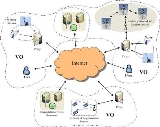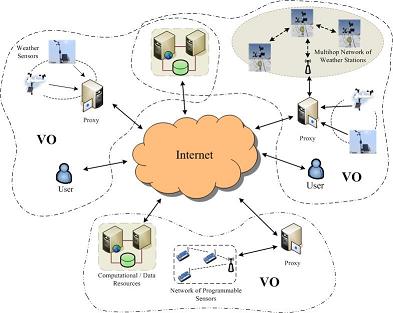
Sensor grid
Encyclopedia
A Sensor Grid integrates wireless sensor networks with grid infrastructures to enable real-time sensor data collection and the sharing of computational and storage resources for sensor data processing and management. It is an enabling technology for building large-scale infrastructures, integrating heterogeneous sensor, data and computational resources deployed over a wide area, to undertake complicated surveillance tasks such as environmental monitoring
.
, data fusion
, data mining
, and distributed database processing can be applied to make sense of the sensor data and generate new knowledge of the environment. The results can in turn be used to optimize the operation of the sensors, or influence the operation of actuators to change the environment. Thus, sensor grids are well suited for adaptive and pervasive computing applications.
, healthcare monitoring of patients, weather monitoring and forecasting
, military and homeland security surveillance
, tracking of goods and manufacturing processes, safety monitoring of physical structures and construction sites, smart homes and offices, and many other uses currently beyond our imagination.
[1] H.B. Lim, et al. Sensor Grid: Integration of Wireless Sensor Networks and the Grid, In Proc. of the IEEE Conference on Local Computer Networks 30th Anniversary (LCN’05), October 2005.
[2] Hingne, V.; Joshi, A.; Houstis, E.; Michopoulos, J. On the Grid and Sensor Networks. In Proc. Of International Workshop on Grid Computing. pages 166-173. Nov. 2003
[3] Crisisgrid (2007): http://www.crisisgrid.org
[4] M. Gaynor, et al. Integrating wireless sensor networks with the grid. IEEE Internet Computing, pages 32–39, Jul/Aug 2004.
[5] H. B. Lim, K. V. Ling, W. Wang, Y. Yao, M. Iqbal, B. Li, X. Yin, and T. Sharma, "The National Weather Sensor Grid," Proc. of the 5th ACM Conference on Embedded Networked Sensor Systems (SenSys 2007), Nov 2007.
[6] The National Weather Sensor Grid: http://nwsp.ntu.edu.sg
Environmental monitoring
Environmental monitoring describes the processes and activities that need to take place to characterise and monitor the quality of the environment...
.
Uses
The sensor grid enables the collection, processing, sharing, visualization, archiving and searching of large amounts of sensor data. There are several rationales for a sensor grid. First, the vast amount of data collected by the sensors can be processed, analyzed, and stored using the computational and data storage resources of the grid. Second, the sensors can be efficiently shared by different users and applications under flexible usage scenarios. Each user can access a subset of the sensors during a particular time period to run a specific application, and to collect the desired type of sensor data. Third, as sensor devices with embedded processors become more computationally powerful, it is more efficient to offload specialized tasks such as image and signal on the sensor devices. Finally, a sensor grid provides seamless access to a wide variety of resources in a pervasive manner. Advanced techniques in artificial intelligenceArtificial intelligence
Artificial intelligence is the intelligence of machines and the branch of computer science that aims to create it. AI textbooks define the field as "the study and design of intelligent agents" where an intelligent agent is a system that perceives its environment and takes actions that maximize its...
, data fusion
Data fusion
Data fusion, is generally defined as the use of techniques that combine data from multiple sources and gather that information into discrete, actionable items in order to achieve inferences, which will be more efficient and narrowly tailored than if they were achieved by means of disparate...
, data mining
Data mining
Data mining , a relatively young and interdisciplinary field of computer science is the process of discovering new patterns from large data sets involving methods at the intersection of artificial intelligence, machine learning, statistics and database systems...
, and distributed database processing can be applied to make sense of the sensor data and generate new knowledge of the environment. The results can in turn be used to optimize the operation of the sensors, or influence the operation of actuators to change the environment. Thus, sensor grids are well suited for adaptive and pervasive computing applications.
 |
| Typical sensor grid architecture |
Applications
A sensor grid based architecture has many applications such as environmental and habitat monitoringCommunity-based monitoring
Community-based monitoring is a form of public oversight, ideally driven by local information needs and community values, to increase the accountability and quality of social services or to contribute to the management of ecological resources...
, healthcare monitoring of patients, weather monitoring and forecasting
Weather forecasting
Weather forecasting is the application of science and technology to predict the state of the atmosphere for a given location. Human beings have attempted to predict the weather informally for millennia, and formally since the nineteenth century...
, military and homeland security surveillance
Surveillance
Surveillance is the monitoring of the behavior, activities, or other changing information, usually of people. It is sometimes done in a surreptitious manner...
, tracking of goods and manufacturing processes, safety monitoring of physical structures and construction sites, smart homes and offices, and many other uses currently beyond our imagination.
Further reading
For sensor grid architectures, designs and applications, see the following:[1] H.B. Lim, et al. Sensor Grid: Integration of Wireless Sensor Networks and the Grid, In Proc. of the IEEE Conference on Local Computer Networks 30th Anniversary (LCN’05), October 2005.
[2] Hingne, V.; Joshi, A.; Houstis, E.; Michopoulos, J. On the Grid and Sensor Networks. In Proc. Of International Workshop on Grid Computing. pages 166-173. Nov. 2003
[3] Crisisgrid (2007): http://www.crisisgrid.org
[4] M. Gaynor, et al. Integrating wireless sensor networks with the grid. IEEE Internet Computing, pages 32–39, Jul/Aug 2004.
[5] H. B. Lim, K. V. Ling, W. Wang, Y. Yao, M. Iqbal, B. Li, X. Yin, and T. Sharma, "The National Weather Sensor Grid," Proc. of the 5th ACM Conference on Embedded Networked Sensor Systems (SenSys 2007), Nov 2007.
[6] The National Weather Sensor Grid: http://nwsp.ntu.edu.sg

